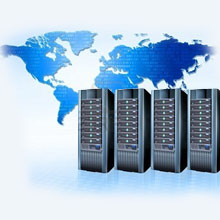 Enterprise computing is a term that refers to a myriad of information technology (IT) tools that businesses use for efficient production operations and back office support. Some business software development firms have designed integrated IT systems that assist users throughout the company to perform numerous functions, and these systems are often touted as enterprise IT computing tools. Whether one defines enterprise IT computing as a single computing system or as an integrated suite of IT tools, it is apparent that most businesses are heavily dependent on IT products to help them to maintain market share, identify opportunities for growth and avoid risk. Here are some examples of enterprise IT computing tools that are commonly used by businesses that operate in a variety of industries, according to the Houston Chronicle.
Enterprise computing is a term that refers to a myriad of information technology (IT) tools that businesses use for efficient production operations and back office support. Some business software development firms have designed integrated IT systems that assist users throughout the company to perform numerous functions, and these systems are often touted as enterprise IT computing tools. Whether one defines enterprise IT computing as a single computing system or as an integrated suite of IT tools, it is apparent that most businesses are heavily dependent on IT products to help them to maintain market share, identify opportunities for growth and avoid risk. Here are some examples of enterprise IT computing tools that are commonly used by businesses that operate in a variety of industries, according to the Houston Chronicle.
Enterprise Resource Planning Systems
Enterprise resource planning (ERP) systems help business professionals to gather, collect, retrieve and analyze data from numerous business functional areas. For example, data that is associated with the acquisition of raw materials for production is often stored within ERP systems. Subsequently, business professionals who include analysts as well as executives can access the data in support of product planning activities. ERP systems are designed to give real time, consolidated views of core business activities like engineering, accounting, finance, human resources, marketing and production. Modern ERP tools integrate with other enterprise systems to receive and provide data for enhanced business analytics.
Customer Relationship Management Systems
Satisfied customers are at the heart of growing businesses, and savvy business leaders realize the value of IT systems that help companies to engage customers, anticipate their needs and quickly respond to their concerns. Customer relationship management (CRM) systems collect data from transactions, social media interactions and other feedback mechanisms. The collected data is used by market research analysts, brand managers and sales managers to guide pricing strategies, suggest modifications of products or packaging and identify new markets for existing products.
Integrated Supply Chain Management Systems
The activities involved in acquiring materials, manufacturing goods, storing and distributing them for sale to end users are complex and require a great deal of coordination. Enterprise IT computing tools like supply chain management (SCM) systems help logistics managers to deliver undamaged goods to domestic and international centers in appropriate amounts and at the right times. SCM systems provide supply chain managers with up to the minute information that they need to monitor product inventory levels, order supplies and track shipments. These systems are often integrated with other enterprise IT computing tools like CRM applications, and supply chain managers can use these tools to provide customers with accurate information about shipped orders and product quality concerns.
Product Lifecycle Management Systems
Product lifecycle management (PLM) systems help engineers and business leaders to coordinate the design, development, testing, production, maintenance and disposal of products that are generated by organizations. Before PLM systems gained popularity, engineers and other business professionals used individual applications to generate product designs that they usually stored locally on their company desktop computers. Today’s engineers and business professionals are able to access product design documents that are configuration managed and available to those with appropriate permission credentials. PLM systems enable companies to identify design efficiencies within their portfolio of products, determine suitable alternatives for raw materials as a function of risk management and even quickly locate company assets that have expertise for specialized development efforts.
Related Resource: Purchasing Manager
Conclusion
Advancements in IT present today’s business leaders with great opportunities to produce unique, high quality products, forecast demand with greater precision and identify trends that lead to innovation. However, greater efficiencies are gained when companies choose integrated automated tools or multifunctional IT systems. These IT systems that are meant to be used by entire organizations and not simply individuals, departments or subdivisions are generally classified as enterprise computing systems.
